Labarrios
labarrios
Learning languages
ENGLISH LANGUAGE. DRONE FLYING. Simultaneous interpretation advanced. Free video lectures,Free Animations, Free Lecture Notes, Free Online Tests, F...
The amazing brains of the real-time interpreters. One morning this summer I paid a visit to the sole United Nations agency in London.

The headquarters of the International Maritime Organization (IMO) sits on the southern bank of the Thames, a short distance upstream from the Houses of Parliament. As I approached, I saw that a ship’s prow, sculpted in metal, was grafted like a nose to the ground floor of this otherwise bland building. Inside I met a dozen or so mostly female IMO translators. They were cheerful and chatty and better dressed than you might imagine for people who are often heard but rarely seen. I walked upstairs to a glass-fronted booth, where I prepared to witness something both absolutely remarkable and utterly routine.
Let’s unpick what she did that morning and itemise its components. As the delegate spoke, Pinkney had to make sense of a message composed in one language while simultaneously constructing and articulating the same message in another tongue.
Exercises for simultaneous. These exercises and more can be found in Conference Interpreting - A Students'Companion, A Gillies, 2001, (p80-83) and are reproduced with the kind permission of Tertium Krakow).
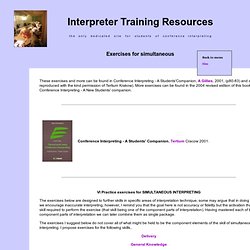
More exercises can be found in the 2004 revised eidtion of this book, Conference Interpreting - A New Students' companion. VI Practice exercises for SIMULTANEOUS INTERPRETING The exercises below are designed to further skills in specific areas of interpretation technique, some may argue that in doing this we encourage inaccurate interpreting, however, I remind you that the goal here is not accuracy or fidelity but the activation that skill required to perform the exercise (that skill being one of the component parts of interpretation).
Speech Repository. English Language & Usage Stack Exchange. English Language & Usage Stack Exchange. Rules for Comma Usage. Use a comma to separate the elements in a series (three or more things), including the last two.

"He hit the ball, dropped the bat, and ran to first base.
" You may have learned that the comma before the "and" is unnecessary, which is fine if you're in control of things. However, there are situations in which, if you don't use this comma (especially when the list is complex or lengthy), these last two items in the list will try to glom together (like macaroni and cheese). Using a comma between all the items in a series, including the last two, avoids this problem. This last comma—the one between the word "and" and the preceding word—is often called the serial comma or the Oxford comma. Use a comma + a little conjunction (and, but, for, nor, yet, or, so) to connect two independent clauses, as in "He hit the ball well, but he ran toward third base.
" One of the most frequent errors in comma usage is the placement of a comma after a coordinating conjunction. Use a comma to avoid confusion.
The Translator's Home Companion. Organización de las Naciones Unidas para la Alimentación y la Agricultura. Filtrar los resultados de búsqueda - Ayuda de Búsqueda web. Según el tipo de sitio que hayas buscado, podrían mostrarse algunos de estos filtros: Acceder al historial: permite limitar los resultados a los lugares en los que hayas estado o que no hayas visitado.
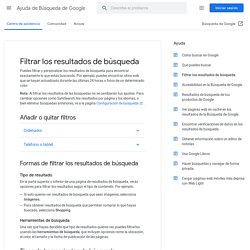
Valoración: sirve para acotar los resultados según la puntuación de otros usuarios de Google. Tipo de cocina: permite filtrar los sitios según el tipo de comida que se sirve en ellos. Precio: sirve para filtrar restaurantes u otros sitios según el precio.
Operadores de búsqueda - Ayuda de Búsqueda web. Si quieres obtener unos resultados más precisos, incluye símbolos o palabras en la búsqueda.
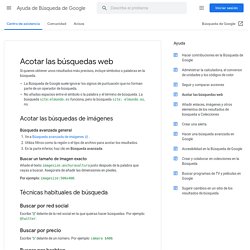
La Búsqueda de Google suele ignorar los signos de puntuación que no forman parte de un operador de búsqueda. No añadas espacios entre el símbolo o la palabra y el término de búsqueda. La búsqueda site:elmundo.es funciona, pero la búsqueda site: elmundo.es, no. Acotar las búsquedas de imágenes Búsqueda avanzada general Ve a Búsqueda avanzada de imágenes.
Semantic alignment - EuroVoc - Unbis (United Nations Thesaurus) - Datasets. IEDCYT (antes CINDOC)-Instituto de Estudios Documentales sobre Ciencia y Tecnología. EuroVoc. Eurovoc Thesaurus. United Nations Bibliographic Information System Thesaurus. Glossaries by Language. UNBISnet - UN Bibliographic Information System. Eurovoc, the EU's multilingual thesaurus— choose your language.
Naciones Unidas. Recursos para traductores.
El espa�ol, lengua de traducci�n.
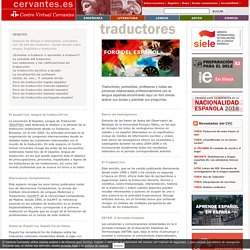
Oteador. Índice temático en español. | Ayuda | Buzón | | Portada del CVC | | Obras de referencia | Actos culturales | Foros | Aula de lengua | Oteador | | Rinconete | El trujamán | | Enviar comentarios |
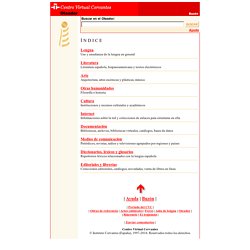
La linterna del traductor. The Translator's Home Companion. Internet Resources for Translators. Euskalterm, Euskal Terminologia banku publikoa - Euskadi.eus. Food and Agriculture Organization of the United Nations. IATE - The EU's multilingual term base. Real Academia Española. TERMCAT – Benvingut al web del TERMCAT. Diccionaris en Línia. Red de Bibliotecas REBIUN. Biblioteca - Biblioteca Universitaria. Inicio Biblioteca Digital Mundial.
Biblioteca Digital Hispánica. Bibliotecas digitales. Biblioteca Virtual Miguel de Cervantes. El Buscón, metabuscador de la BNE. Biblioteca Nacional de España. Biblioteca Digital - Aula.Int. Bienvenido a la Biblioteca Digital de Traducción de Aula.int.

Bases de datos - Biblioteca Universitaria. Catálogos. Biblioteca Nacional de España. Bibliotecas. De Bibliotecas y Archivos del CSIC da soporte a la excelencia científica, garantizando a la comunidad científica el acceso a la información.
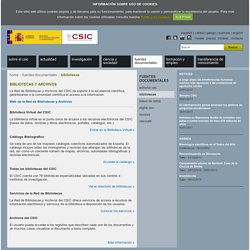
Biblioteca Digital - Aula.Int. Lista alfabética de títulos - Biblioteca Universitaria. Bibliotecas > Catálogos de Bibliotecas Públicas > Portada. Liburuklik: Home. Descubrir colecciones - Biblioteca Digital Hispánica. Bibliotecas digitales. Inicio Biblioteca Digital Mundial. Bases de datos de las Naciones Unidas. Libro > Bases de datos del ISBN > Base de datos de libros. Esta base de datos contiene referencias bibliográficas de los libros editados en España desde 1972, año en que nuestro país se unió al sistema ISBN.
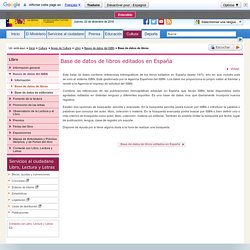
Está gestionada por la Agencia Española del ISBN. Los datos los proporciona el propio editor al tramitar y remitir a la Agencia el impreso de solicitud del ISBN. Contiene las referencias de las publicaciones monográficas editadas en España que llevan ISBN, tanto disponibles como agotadas, editadas en distintas lenguas y diferentes soportes.
Sistema de Archivo de Documentos. Home. Asociación de Traductores, Correctores e Intérpretes de Lengua Vasca. La Asociación de Traductores, Correctores e Intérpretes de Lengua Vasca (en euskera Euskal Itzultzaile, Zuzentzaile eta Interpreteen Elkartea, EIZIE) es una organización fundada en 1987 que vela por la optimización de los servicios que brindan los traductores, correctores e intérpretes que trabajan con la lengua vasca. Su primer presidente fue Juan María Lekuona. Es miembro de la Federación Internacional de Traductores (FIT)[1] y de CEATL (Conseil Européen des Traducteurs Littéraires).[2] Publicaciones[editar] EIZIE edita o dirige las siguientes publicaciones: Patrocinio[editar] EIZIE recibe el apoyo de las siguientes instituciones: Referencias[editar] Enlaces externos[editar]
Index Translationum - Bibliografía Internacional de la Traducción. La base de datos contiene una información bibliográfica acumulativa sobre las obras traducidas y publicadas en un centenar de Estados Miembros de la UNESCO entre 1979 y 2009. Más de 1.800.000 referencias de todas las disciplinas: literatura, ciencias sociales y humanas, ciencias exactas y naturales, arte, historia, etc. Búsqueda bibliográfica en línea Las referencias anteriores a 1979, pueden ser consultadas en la versión impresa, que se encuentra en las bibliotecas depositarias y en la biblioteca de la UNESCO, París.
Diccionario panhispánico de dudas. DLE: diccionario - Diccionario de la lengua española - Edición del Tricentenario. Base de datos de editoriales. ASETRAD. Inicio. Aula int 2 masgramatica. ACE Traductores (@acetraductores)
Internet Archive: Wayback Machine.
Wayback Machine. The Wayback Machine is a digital archive of the World Wide Web and other information on the Internet created by the Internet Archive, a nonprofit organization, based in San Francisco, California, United States. The Internet Archive launched the Wayback Machine in October 2001.[4][5] It was set up by Brewster Kahle and Bruce Gilliat, and is maintained with content from Alexa Internet.
The service enables users to see archived versions of web pages across time, which the archive calls a "three dimensional index". Since 1996, the Wayback Machine has been archiving cached pages of websites onto its large cluster of Linux nodes. It revisits sites every few weeks or months and archives a new version. Sites can also be captured on the fly by visitors who enter the site's URL into a search box. The name Wayback Machine was chosen as a reference to the "WABAC machine" (pronounced way-back), a time-traveling device used by the characters Mr.
History[edit] Origins[edit]
Documentacion t1.










